Abstract
Agarose-based gels were produced either by freeze-drying or by supercritical drying for crystal violet (CV) removal from aqueous solutions. The microporosity features of these structures highly affected the final adsorption properties. In particular, agarose cryogels were characterized by a macroporous and irregular morphology, with a low value of specific surface area (11 ± 6 m2/g) with respect to the nanoporous agarose aerogels (154 ± 12 m2/g). To test the efficacy of CV removal, two different types of adsorption test were performed, i.e., batch-mode and multi-step mode. Operating in the multi-step mode, the adsorption performance was larger both for cryogels and aerogels, since this adsorption method allowed a more effective contact between CV and agarose adsorbent. In particular, using 300 mg of cryogels, a removal efficiency of 74% was achieved; using the same quantity of aerogels, 96% of removal efficiency was reached after eight steps of adsorption. Desorption of CV from aerogels was realized using ascorbic acid and, after regeneration, 93% of removal efficiency was preserved, even after three cycles in multi-step filtration mode.
1. Introduction
Several pollutants, such as organic dyes, heavy metal ions and bacteria, can cause serious problems to human health and the environment [1,2,3]. For this reason, it is important that they are removed efficiently from water basins [4,5,6]. Among the organic dyes, crystal violet (CV) has been reported as a recalcitrant dye molecule that can persist in the environment for a long period of time and can induce toxic effects [7,8]. CV is a well-known dye since it is used for various purposes, including medicine, textile dyeing, and paper coloration [9]. It is formed by three benzene aromatic rings with six N-methyl groups that make it potentially mutagenic and carcinogenic, especially for mammalian cells [10], hence raising environmental and health concerns.
Different purification techniques, such as oxidative degradation, photodegradation, and electrocoagulation, have been proposed to remove organic dyes from wastewaters [11,12,13]; however, they suffer from various drawbacks due to the difficulties in applying them to large-scale plants along with high energy and chemicals consumption [14]. For these reasons, adsorption is often used for dyes and organic substances removal, thanks to its easy operation, ability to treat concentrated forms of the dyes and the possibility of reusing the adsorbents after regeneration [14]. Moreover, adsorption has advantages over the other methods in terms of simple design and initial investment cost.
Several authors tried to remove CV from wastewater using different solid adsorbents [14,15,16].
The adsorption process involves mass transfer mechanisms to transfer a substance from the liquid phase to the surface and the bulk of a solid, due to the formation of physical and/or chemical bonding.
The initial high cost of the solid adsorbents and the need for an inexpensive regeneration system has led to the use of some natural materials [17,18], characterized by a good affinity with the dye [19] and a high specific surface area [19,20,21].
Gels can be used as adsorbent materials since they can have the above discussed properties. They can be termed ‘xerogels’ when drying is carried out at room pressure, and ‘cryogels’ when the ice-crystals inside the hydrogels are sublimated by freeze-drying. As a rule, these two types of material have a macroporous structure, characterized by large and irregular pores. By contrast, ‘aerogels’ can be obtained using supercritical CO2 (SC-CO2) assisted drying technique, in which the solvent is removed thanks to the formation of a supercritical mixture CO2 plus organic solvent that works at almost zero surface tension and avoids the collapse of the native gel nanofibrous structure [22,23,24].
Some of the papers present in the literature dealing with CV removal are reported in Table 1.

Table 1.
Papers about CV removal.
According to the literature investigation reported in Table 1, different types of bio-based nanocomposites were studied for CV removal from water. The most used bio-based adsorbents were in the form of hydrogels, xerogels and particles. Gels were generally functionalized using magnetic nanoparticles, to improve their removal efficiency, but time-consuming processes were employed. Particles required very simple processes for their production, but the separation from the aqueous solution was more complex and difficult to scale up to industrial applications.
Some attempts have been also performed using solid adsorbents in form of cryogels to remove CV from wastewaters. These gels were prepared by freeze-drying, starting from different raw materials, such as: low-cost chitin and psyllium biopolymers [30], sugarcane bagasse-bentonite and sodium alginate [31]. However, this procedure lasted about 48 h, leading to the formation of macroporous structures characterized by low values of specific surface area.
Agarose is a natural polysaccharide derived from seaweeds and is the purified fraction of agar [22]. Agarose gels are generally used for electrophoresis application, which is based on the separation of nucleic acid (DNA or RNA) fragments on their size [32]. In some papers, agarose cryogels were used as solid adsorbents for the removal of various dyes. In particular, Chen et al. [33] produced cryogels formed by agarose and graphene oxide (GO), using a vacuum freeze-drying method. These cryogels were tested for the removal of methylene blue and their adsorption capacity was 578 mg/g. The specific surface area values were very low, ranging from 1 m2/g for agarose only, up to 8.18 m2/g for a GO loading equal to 80% w/w with respect to agarose. Also, Tan et al. [34] tested an innovative g-C3N4 hybrid agarose cryogel for the removal of methylene blue. Other authors [35,36] tested the adsorption capacity of the agarose-based cryogels loaded with metal-organic frameworks (MOFs) and zeolitic imidazolate, to test the adsorption capacity of these gels under light irradiation, for the removal of methylene blue.
To obtain highly porous and nanofibrous structures, supercritical gel drying could be considered a relevant option [22,23,24,37]; Guastaferro et al. [22] performed a supercritical drying of agarose-based alcogels at 200 bar and 40 °C that led to the production of aerogels characterized by a mesoporous structure, with a specific surface area up to 170 m2/g.
Therefore, in this work, agarose-based structures (aerogels and cryogels) have been used to remove CV from an aqueous medium by adsorption, with the aim of demonstrating that SC-CO2 gel drying could be a more effective technique in preserving the morphological features of the starting hydrogels, suitable for the adsorption process of a specific, difficult to remove, toxic dye (CV). The regeneration of the best adsorbent candidate has been also performed.
2. Materials and Methods
2.1. Materials
Agarose (AG, Type I-A, low Electroendosmosis (EEO), powder), crystal violet (CV, purity ≥ 90%) and ethanol (purity 99%) were supplied by Sigma Aldrich (Milan, Italy). CO2 (99.9% purity) was supplied by Morlando Group Srl (Sant’Antimo, Naples, Italy).
2.2. Hydrogel Preparation
Agarose hydrogels were formed using 0.6 g of agarose (3% w/w) dissolved in 20 mL of distilled water and the solution was heated up to 80–90 °C, until complete polymer solubilization. Agarose aqueous solution was subsequently cooled down to room temperature to induce the gel formation, as reported in Figure 1.
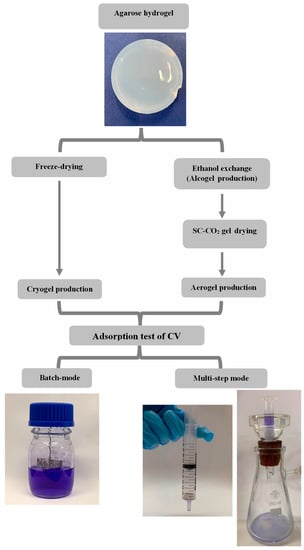
Figure 1.
Aerogel and cryogel preparation method and representation of the different adsorption experiments.
2.3. Cryogel Preparation
After hydrogels preparation, they were placed in the cooling chamber of a programmable cryostat (LyoQuest-55 Plus ECO, Seneco Srl, Milan, Italy), set at −50 °C, under vacuum, overnight. At the end of this process, defrosting was carried out at 25 °C for 1 h.
2.4. Aerogel Preparation
Agarose hydrogels were first transformed in alcogels using a multi-step water exchange, using solutions at increasing volumes of ethanol (10, 30, 50, 70, 90, 100%). The last step (ethanol 100%) lasted overnight, whereas the previous ones lasted 1 h. Then, the alcogels were dried by SC-CO2 at 200 bar and 40 °C for 5 h [22]. The drying process was performed in a laboratory apparatus equipped with a 316 stainless steel high-pressure vessel with an internal volume of 200 mL. The alcogels were placed in the vessel that was filled from the bottom with SC-CO2 up to the desired pressure using a high-pressure pump (Gilson, mod. 305, Middleton, WI, USA). The apparatus operated in a continuous mode for 5 h. At the end, the vessel was slowly depressurized for 1 h. More details about the experimental plant and the production method can be found in [37].
2.5. Morphology and Physical Properties Analysis
Agarose samples were cut using liquid nitrogen to preserve their inner structure and sputter coated with gold (Agar Auto Sputter Coater mod. 108 A, Stansted, UK) at 40 mA for 120 s; then, they were analyzed by a field emission scanning electron microscope (FESEM, mod. LEO 1525, Carl Zeiss SMT AG, Oberkochen, Germany) to observe their morphology.
Bulk density of agarose cryogels and aerogels was measured by the ratio between sample mass and volume, expressed in g/cm3.
The percentage of samples shrinkage was measured using the following equation:
where Vf and Vi are the agarose hydrogel volume and the final cryo/aerogel volume, respectively.
Brunauer-Emmett-Teller (BET) specific surface area of the samples was determined by a Nova 1200e Surface Area (Quantachrome Instruments, Boynton Beach, FL, USA). A 200 mg mass of each agarose sample was analyzed by N2 adsorption at −196 °C.
Fourier transform infrared (FT-IR) spectra were obtained using a M2000 FT-IR spectrophotometer (MIDAC Co, Costa Mesa, CA, USA) to investigate the chemical interactions between CV and the polymeric matrix during the adsorption process. Pellets were prepared by mixing the produced materials and KBr (1:100 by weight). Scans were performed at a resolution of 32 cm−1.
2.6. Adsorption Tests
CV was selected as a model dye to test the adsorbent capacity of agarose porous solids. To analyze the concentration of the adsorbed dye by an UV-Vis spectrophotometer (Model Cary 50, Varian, Polo Alto, CA, USA), a calibration curve of CV at a wavelength (λ) of 591 nm was obtained. CV absorbance was correlated to its concentration in a water solution by the Lambert Beer law.
2.6.1. Adsorption Tests in Batch-Mode
Adsorption tests in batch-mode were carried out to remove 5 mg/L of CV from an aqueous solution. A 50 mL volume of the test solution and different quantities of agarose porous solid were kept in bottles at room conditions, as reported, for example, in Figure 1, and stirred at 200 rpm. The name abbreviations used for all tests are shown in Table 2.

Table 2.
Name abbreviations for all tests.
The dye adsorption kinetic was obtained recording CV absorbance every hour, using the UV-Vis spectrophotometer previously described.
2.6.2. Adsorption Tests in Multi-Step Mode
To improve the adsorption process, some experiments were carried out using the apparatus reported in Figure 1 [33,38,39]. A 10 mL syringe was prepared loading a given quantity of cryo/aerogel at the bottom of the syringe and adding the dye solution, at an initial CV concentration of 5 mg/L. The solution was, then, filtered by letting it to flow by gravity through the bed material located on the base of the syringe. Filtration was repeated several times, N, using in all cases the same lot of solution, recovered in a glass flask at the end of the previous step. The concentration of the filtered solution, at the end of each step, was measured by UV-Vis spectrophotometry. The tests were named as indicated before (Table 2).
2.7. Desorption Test
Desorption experiments were performed in batch-mode, using a 1 mol/L ascorbic acid solution. The desorption eluent was added to the exhaust adsorbent material and stirred for 3 h. Then, the adsorbent material was removed from the ascorbic acid solution, washed with water, dried at room temperature, and reused for other filtration experiments.
3. Results and Discussion
The first characterizations were performed to investigate the samples’ morphological features. Agarose-based structures obtained by freeze-drying and supercritical drying preserved the same shape, but not the same size as the starting hydrogels. Shrinkage was 36% and 20% for cryogels and aerogels, respectively. These values were calculated using sample dimensions (Table 3) and the formula reported in Section 2.5.

Table 3.
Cryo/Aerogel dimensions before and after the drying process.
FE-SEM analysis was performed to observe the section and surface of each sample produced; the results are reported in Figure 2.
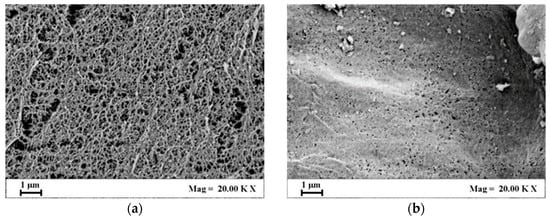

Figure 2.
FE-SEM images of 3% w/w agarose aerogel: (a) section and (b) surface. Images of 3% w/w cryogel: (c) section and (d) surface.
FE-SEM images in Figure 2a,b show that the aerogels were characterized by a regular micro- and nano-porous morphology, with open and interconnected pores in the cross-section and on the surface of the sample; whereas cryogels showed a less regular macroporous structure (Figure 2c,d). Supercritical drying is able to preserve the nanofibrous structure of the starting hydrogel thanks to the zero-surface-tension of the supercritical mixture CO2 plus organic solvent, formed during the drying process [22,37]. In the case of freeze-drying, the nucleation of ice crystals and their subsequent removal by sublimation tend to destroy the gel nanostructure. In particular, freezing and sublimation steps led to the development of significant stresses within the polymeric matrix since, during freezing, water expands, and mechanical stresses are exerted on the surrounding polymeric chains; moreover, capillary stresses destroy the gel nanostructure during ice crystals sublimation [22,33,34,35,36].
3.1. Porosity and Surface Area Measurement
Surface area and porosity are the main properties that influence the adsorption behavior of porous materials. Indeed, materials having the same weight and volume, but different specific surface area, may differ in terms of surface activity and adsorption volume. For this reason, bulk porosity and BET analyses for 3% w/w agarose aerogels and cryogels were performed and the obtained values are reported in Table 4.

Table 4.
Porosity and surface area values of 3% w/w agarose cryo/aerogels.
Agarose-based samples produced by supercritical drying showed higher values of bulk porosity and much larger values of specific surface area with respect to the samples produced by freeze-drying technique. Especially, surface area was more than ten times larger in the case of aerogels: 154 m2/g for aerogel against 11 m2/g for cryogel. These results agree with FE-SEM images showing that the aerogels structure was entirely characterized by small pores, responsible for the larger surface area. Therefore, a larger number of active sites available for dye adsorption can characterize aerogels.
3.2. Adsorption Tests in Batch-Mode: Aerogels (A) vs. Cryogels (C)
Different amounts of aerogel (150, 200 and 300 mg for A1, A2 and A3 experiments, respectively) were used to test the removal efficiency of CV from 50 mL of an aqueous solution. The apparatus used for these experiments is illustrated in Figure 1. CV concentration values were recorded using a UV-Vis spectrophotometer and their values are plotted in Figure 3.
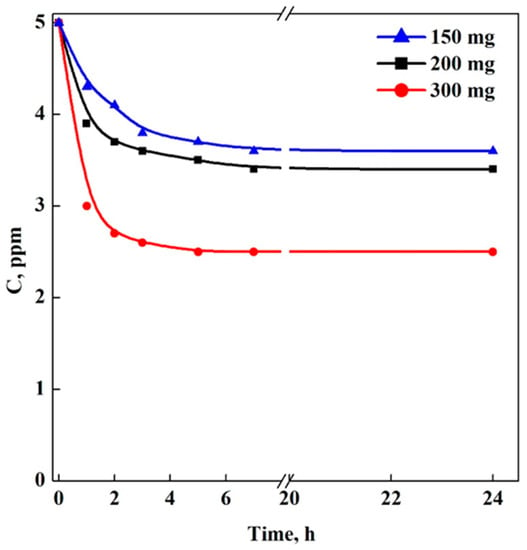
Figure 3.
Adsorption kinetics of aerogel samples analyzed in the experiments of Set A (Aerogels) performing a batch adsorption (T = 25 °C, rpm = 200, λ = 591) and using three different amounts of aerogels: 150 mg (blue line), 200 mg (black line) and 300 mg (red line).
Figure 3 shows that the increase in the quantity of adsorbent used, produced a larger dye adsorption, up to 50% of CV removal. This result is due to the availability of a larger number of active sites that can promote more physical-chemical interactions with CV. Indeed, the increased amount of -OH groups could lead to increased electrostatic interactions between crystal violet and agarose. The three curves showed an asymptote at about 6 h of testing; this result could indicate saturation of the active sites useful for adsorption.
Cryogels were also used for adsorption tests in batch-mode, testing the same dye concentration and quantity of solid material of the previous case. The obtained values, over time, are reported in Figure 4.
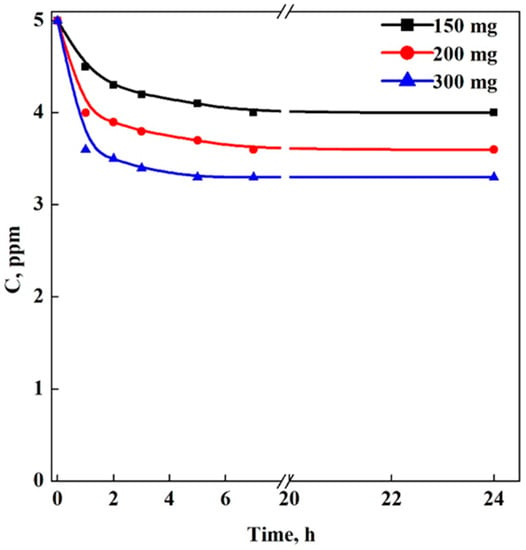
Figure 4.
Adsorption kinetics of cryogel samples analyzed in the experiments of Set C (Cryogels) performing a batch adsorption (T = 25 °C, rpm = 200, λ = 591) and using three different amounts of cryogels: 150 mg (black line), 200 mg (red line) and 300 mg (blue line).
The trend described for the aerogels was also observed for cryogels: the increase in adsorbent amount led to a higher CV removal efficiency, at up to 34% of dye removal. Also in this case, a pseudo-asymptotic behavior was observed around 6 h.
However, the asymptotic values of cryogels were larger than those observed for the corresponding aerogels; cryogels possessed a lower number of active sites useful for adsorption and this result can also be correlated with the lower specific surface area of these samples.
However, the concentration of CV did not decrease down to 2.5 ppm for A3, and down to 3.3 ppm for C3. Summarizing, the aerogels showed a better adsorbent performance when compared with the samples obtained by freeze-drying; but the obtained performances were not satisfactory.
3.3. Adsorption Tests in Multi-Step Mode: Aerogels (A) vs. Cryogels (C)
To improve the adsorption performance, adsorption tests in multi-step mode were realized, using again different amounts of aerogel (150, 200 and 300 mg for the Set A1, A2 and A3, respectively). The apparatus used for these experiments is reported in Figure 1. The filtered flow rate was about 0.1 mL/min and the resulting concentrations, after each step of filtration and for each experiment, are also plotted in Figure 5, in which CV concentration is graphed against the number of steps (N).
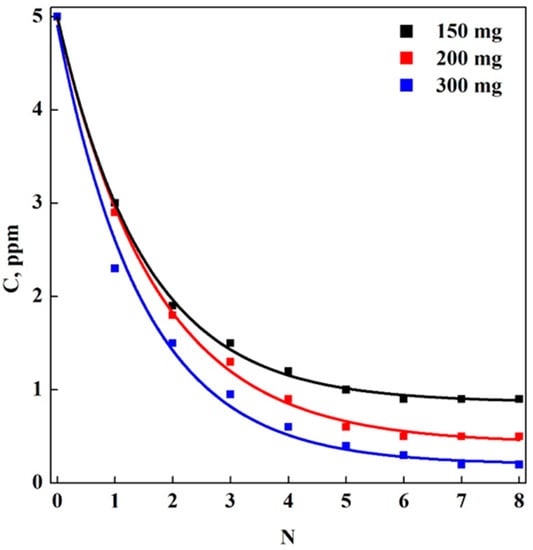
Figure 5.
Adsorption kinetics of aerogel samples analyzed in the experiments of Set A (Aerogels) performing a multi-step adsorption (T = 25 °C, flow rate = 0.1 mL/min) and using three different amounts of aerogels: 150 mg (black line), 200 mg (red line) and 300 mg (blue line).
A qualitative way to highlight the different adsorbent performance between aerogels and cryogels is reported in Figure S1. It shows photos of the solutions before adsorption (Figure S1a) and after some steps of adsorption (Figure S1b,d,f). Cryogel adsorption related solutions are also reported for comparison purposes (Figure S1c,e,g).
It is relevant to note that the solution reported in Figure S1f is practically transparent, indicating the disappearance (adsorption) of the dye, using 300 mg of aerogels as adsorbent materials.
Operating in the multi-step mode, the adsorption performance was larger than using the previous batch-mode. This result can be highlighted by comparing the experiments in which the same adsorbent quantity was used (see Figure 5). This operation mode allowed a more effective contact between the solution and the active sites of the solid material: using 300 mg of aerogel, 96% of CV removal was achieved after eight adsorption steps.
Comparing this result with the others reported in the literature [40], it is possible to claim that the same value of removal efficiency of the tested dye has been reached in this work, without using a combination of processes. For example, Haounati et al. [40] used adsorption in combination with photocatalysis. However, photocatalysis can be considered as a promising alternative for dye removal when it is able to provide a self-cleaning property of the solid adsorbent; but, in this case, the regeneration step was required using another solvent. Therefore, the regeneration step was not immediate and post-treatments were also required [41] to separate the two phases.
Cryogels were also used to perform multi-step filtration tests and concentration values, as a function of the number of steps, N, are reported in Figure 6.
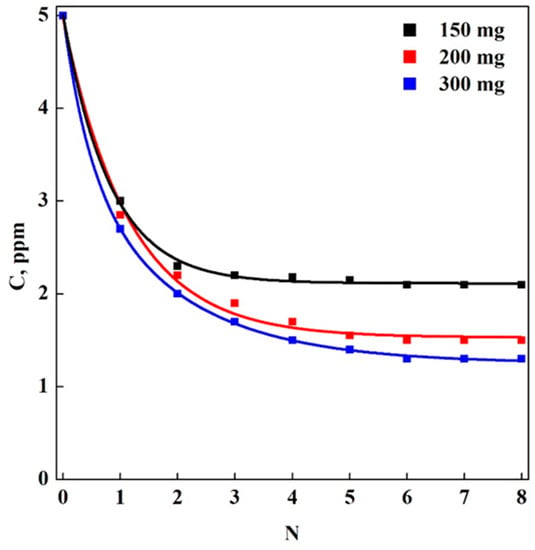
Figure 6.
Adsorption kinetics of cryogel samples analyzed in the experiments of Set C (Cryogels) performing a multi-step adsorption (T = 25 °C, flow rate = 0.1 mL/min) and using three different amounts of cryogels: 150 mg (black line), 200 mg (red line) and 300 mg (blue line).
Comparing Figure 6 with Figure 4, it is possible to identify the same trend as in batch-mode operation; but, again, aerogels showed a better overall performance with respect to cryogels.
Therefore, also in this adsorption experiment, the comparison between the adsorbent performance of the materials obtained using the two different preparation processes confirms a better performance of agarose aerogels with respect to agarose cryogels, resulting in a higher removal efficiency of the dye present in the solution. In the case of cryogels, the highest removal (set C3) was 74%; whereas, in the case of aerogels (set A3) was 96% after eight steps. This result could be again attributed to the higher specific surface area of the aerogels than cryogels and, therefore, to their larger number of accessible active sites for CV adsorption. Moreover, the multi-step procedure allowed the liquid access to a larger number of active sites; some of them were not accessed in batch-mode. Therefore, operating in batch-mode, pseudo-asymptotes were observed that were not related to the complete saturation of the adsorbent material. The adsorption kinetics showed that this configuration allowed to use the surface and the inner mesoporosity of three-dimensional structures; indeed, the dye is initially adsorbed on the surface and, then, through the diffusion process, it is adsorbed on the active sites present in the inner structure [25,26,27,28,29]. According to the literature, the most used configuration for adsorption process is represented by batch-mode; for this reason, particles are most frequently used as adsorbent materials since they allow an effective contact between solids and liquid medium due to their large surface area. However, time-consuming processes are required to separate the two phases [14,15,16,28,29]. Therefore, the multi-step mode has a good potential as an adsorption process, since this configuration allows the dye to occupy all the available sites and a three-dimensional structure, characterized by a large mesoporosity (aerogels), can be used and easily separated before regeneration. Moreover, this approach is not energy-consuming compared with other adsorption processes.
The experimental points were fitted by the continuous lines reported in Figure 3, Figure 4, Figure 5 and Figure 6. The equation that was used to provide these curves was the following one:
The best aerogel candidate was regenerated using a 1 M solution of ascorbic acid. After CV desorption, the aerogels were used for other 3 cycles of adsorption, and they preserved a 93% of the original adsorption capacity.
3.4. FT-IR Analysis
In Figure 7, FT-IR spectra of agarose powder, crystal violet and agarose aerogel and cryogel after CV adsorption tests are reported.
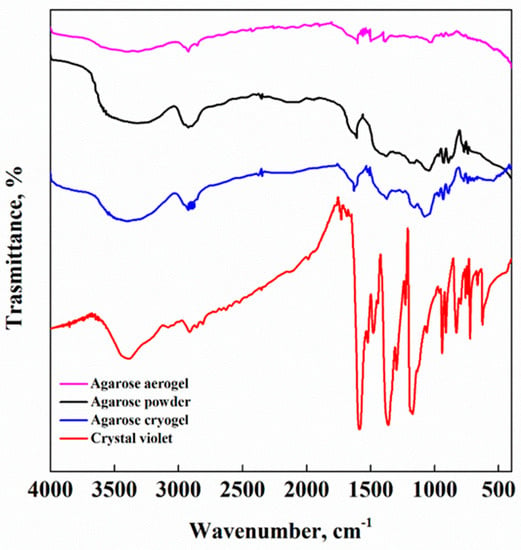
Figure 7.
FT-IR analysis of agarose powder (black line), crystal violet (red line), agarose cryogel after adsorption (blue line) and agarose aerogel after adsorption (violet line).
FT-IR spectrum of agarose powder showed the typical peaks reported in the literature, at a wavelength of approximately 3300 and 2900 cm−1 that correspond to the stretching vibrations of the -OH and -CH bonds, respectively [38]. There were also peaks at 1161 and 1060 cm−1 that correspond to the vibrations of C-O-C and C-OH bonds, respectively, and at 770, 890 and 929 cm−1 that are referred to the flexion of 3.6 anhydro-b-galactose skeleton, constituting the agarose macromolecule. FT-IR spectrum of the dye showed characteristic peaks at wavenumbers of 3400 cm−1 (-OH vibrations), 2900 cm−1 (C=C stretching), 1588 cm−1 (C-H bending), 1300 and 1178 cm−1, due to tertiary amines [42]. The analysis of FT-IR spectra related to the cryo/aerogels after the adsorption process revealed that cryogel spectrum was very similar to that of agarose powder: only the intensity of the peaks was slightly decreased. In the case of aerogel, a strong increase in the intensity of hydroxyl group (3300 cm−1) and the appearance of the positively charged amino group (1330 cm−1) can be detected, indicating the presence of physical-chemical interactions between the agarose and the dye. Therefore, an electrostatic interaction between agarose hydroxyl groups and positively charged amino groups of CV was formed, promoting a more effective dye removal during adsorption tests.
4. Conclusions
Agarose aerogels produced by supercritical drying were confirmed to be successful in eliminating crystal violet from water only by adsorption, operating in a multi-step mode (eight steps). Up to 96% of the pollutant was eliminated at the best operating conditions. Therefore, even recalcitrant pollutants can be processed using this porous biomaterial.
Moreover, agarose aerogels, after regeneration using ascorbic acid, preserved almost completely their adsorption properties, at least up to three cycles of adsorption.
The results of this work should be considered as a proof of concept for developing bio-based materials using an efficient process that could be easily scalable to industrial level, and to test the efficacy of this biopolymer for an almost complete removal of a toxic dye using a simple and inexpensive adsorption process. The regeneration step was also performed and no post-treatments were required to accurately separate the solid material from the liquid solution.
Supplementary Materials
The following supporting information can be downloaded at: https://www.mdpi.com/article/10.3390/app13010463/s1, Figure S1: Image of CV solution before the adsorption process (a); images of CV solution after 8 steps of filtration for 100 mg of aerogel (b) and 100 mg of cryogel (c); images of CV solution after 8 steps of filtration for 200 mg of aerogels (d) and 200 mg of cryogel (e); images of CV solution after 8 steps of filtration for 300 mg of aerogel (f) and 300 mg of cryogel (g).
Author Contributions
Conceptualization, L.B. and M.G.; methodology, L.B., S.C. and M.G.; investigation, M.G.; resources, E.R.; writing—original draft preparation, L.B., M.G. and E.R.; writing—review and editing, L.B., S.C., M.G. and E.R.; supervision, E.R. All authors have read and agreed to the published version of the manuscript.
Funding
This research received no external funding.
Data Availability Statement
Not applicable.
Conflicts of Interest
The authors declare no conflict of interest.
References
- Wang, X.; Guo, Y.; Yang, L.; Han, M.; Zhao, J.; Cheng, X. Nanomaterials as Sorbents to Remove Heavy Metal Ions in Wastewater Treatment. J. Environ. Anal. Toxicol. 2012, 2, 1000154. [Google Scholar] [CrossRef]
- Mishra, S.; Bharagava, R.N.; More, N.; Yadav, A.; Zainith, S.; Mani, S.; Chowdhary, P. Heavy Metal Contamination: An Alarming Threat to Environment and Human Health. In Environmental biotechnology: For Sustainable Future; Springer: Singapore, 2019; pp. 103–125. [Google Scholar] [CrossRef]
- Chaukura, N.; Gwenzi, W.; Tavengwa, N.; Manyuchi, M.M. Biosorbents for the Removal of Synthetic Organics and Emerging Pollutants: Opportunities and Challenges for Developing Countries. Environ. Dev. 2016, 19, 84–89. [Google Scholar] [CrossRef]
- Katheresan, V.; Kansedo, J.; Lau, S.Y. Efficiency of various recent wastewater dye removal methods: A review. J. Environ. Chem. Eng. 2018, 6, 4676–4697. [Google Scholar] [CrossRef]
- Khattri, S.D.; Singh, M.K. Colour Removal from Synthetic Dye Wastewater Using a Bioadsorbent. Water Air Soil. Pollut. 2000, 120, 283–294. [Google Scholar] [CrossRef]
- Dutta, S.; Gupta, B.; Srivastava, S.K.; Gupta, A.K. Recent advances on the removal of dyes from wastewater using various adsorbents: A critical review. Mater. Adv. 2021, 2, 4497–4531. [Google Scholar] [CrossRef]
- Mirza, A.; Ahmad, R. An efficient sequestration of toxic crystal violet dye from aqueous solution by Alginate/Pectin nanocomposite: A novel and ecofriendly adsorbent. Groundw. Sustain. Dev. 2020, 11, 100373. [Google Scholar] [CrossRef]
- Cheruiyot, G.K.; Wanyonyi, W.C.; Kiplimo, J.J.; Maina, E.N. Adsorption of toxic crystal violet dye using coffee husks: Equilibrium, kinetics and thermodynamics study. Sci. Afr. 2019, 5, e00116. [Google Scholar] [CrossRef]
- Assassi, M.; Madjene, F.; Harchouche, S.; Boulfiza, H. Photocatalytic treatment of Crystal Violet in aqueous solution: Box–Behnken optimization and degradation mechanism. Environ. Prog. Sustain. Energy 2021, 40, e13702. [Google Scholar] [CrossRef]
- Yu, k.; Yang, S.; Liu, C.; Chen, H.; Li, H.; Sun, C.; Boyd, S.A. Degradation of Organic Dyes via Bismuth Silver Oxide Initiated Direct Oxidation Coupled with Sodium Bismuthate Based Visible Light Photocatalysis. Environ. Sci Technol. 2012, 46, 7318–7326. [Google Scholar] [CrossRef]
- Golmohammadi, M.; Honarmand, M.; Ghanbari, S. A green approach to synthesis of ZnO nanoparticles using jujube fruit extract and their application in photocatalytic degradation of organic dyes. Spectrochim. Acta—Part A Mol. Biomol. Spectrosc. 2020, 229, 117961. [Google Scholar] [CrossRef]
- Shi, X.; Tian, A.; You, J.; Yang, H.; Wang, Y.; Xue, X. Degradation of organic dyes by a new heterogeneous Fenton reagent—Fe2GeS4 nanoparticle. J. Hazard Mater. 2018, 353, 182–189. [Google Scholar] [CrossRef] [PubMed]
- Titchou, F.E.; Zazou, H.; Afanga, H.; El Gaayda, J.; Akbour, R.A.; Hamdani, M. Removal of Persistent Organic Pollutants (POPs) from water and wastewater by adsorption and electrocoagulation process. Groundw. Sustain. Dev. 2021, 13, 100575. [Google Scholar] [CrossRef]
- Mittal, A.; Mittal, J.; Malviya, A.; Kaur, D.; Gupta, V.K. Adsorption of hazardous dye crystal violet from wastewater by waste materials. J. Colloid Interface Sci. 2010, 343, 463–473. [Google Scholar] [CrossRef]
- El-Sayed, G.O. Removal of methylene blue and crystal violet from aqueous solutions by palm kernel fiber. Desalination 2011, 272, 225–232. [Google Scholar] [CrossRef]
- Wang, X.S.; Chen, J.P. Biosorption of congo red from aqueous solution using wheat bran and rice bran: Batch studies. Sep. Sci. Technol. 2009, 44, 1452–1466. [Google Scholar] [CrossRef]
- Ramdani, A.; Taleb, S.; Benghalem, A.; Ghaffour, N. Removal of excess fluoride ions from Saharan brackish water by adsorption on natural materials. Desalination 2010, 250, 408–413. [Google Scholar] [CrossRef]
- Arora, R. Adsorption of heavy metals-a review. Mater Today Proc. 2019, 18, 4745–4750. [Google Scholar] [CrossRef]
- Ip, A.W.M.; Barford, J.P.; McKay, G. Reactive black dye adsorption/desorption onto different adsorbents: Effect of salt, surface chemistry, pore size and surface area. J. Colloid Interface Sci. 2009, 337, 32–38. [Google Scholar] [CrossRef]
- Siahkamari, M.; Jamali, A.; Sabzevari, A.; Shakeri, A. Removal of Lead(II) ions from aqueous solutions using biocompatible polymeric nano-adsorbents: A comparative study. Carbohydr. Polym. 2017, 157, 1180–1189. [Google Scholar] [CrossRef]
- Gupta, V.K.; Suhas. Application of low-cost adsorbents for dye removal—A review. J. Environ. Manag. 2009, 90, 2313–2342. [Google Scholar] [CrossRef]
- Guastaferro, M.; Baldino, L.; Reverchon, E.; Cardea, S. Production of porous agarose-based structures: Freeze-drying vs. supercritical CO2 drying. Gels 2021, 7, 198. [Google Scholar] [CrossRef] [PubMed]
- Chaurasiya, V.; Singh, J. An analytical study of coupled heat and mass transfer freeze-drying with convection in a porous half body: A moving boundary problem. J. Energy Storage 2022, 55, 105394. [Google Scholar] [CrossRef]
- Guastaferro, M.; Reverchon, E.; Baldino, L. Agarose, alginate and chitosan nanostructured aerogels for pharmaceutical applications: A short review. Front. Bioeng. Biotechnol. 2021, 9, 688477. [Google Scholar] [CrossRef] [PubMed]
- Pourjavadi, A.; Hosseini, S.H.; Seidi, F.; Soleyman, R. Magnetic removal of crystal violet from aqueous solutions using polysaccharide-based magnetic nanocomposite hydrogels. Polym. Int. 2012, 62, 1038–1044. [Google Scholar] [CrossRef]
- Zhang, Q.; Zhang, T.; He, T.; Chen, L. Removal of crystal violet by clay/PNIPAm nanocomposite hydrogels with various clay contents. Appl. Clay Sci. 2014, 90, 1–5. [Google Scholar] [CrossRef]
- Shirsath, S.R.; Patil, A.P.; Bhanvase, B.A.; Sonawane, S.H. Ultrasonically prepared poly(acrylamide)-kaolin composite hydrogel for removal of crystal violet dye from wastewater. J. Environ. Chem. Eng. 2015, 3, 1152–1162. [Google Scholar] [CrossRef]
- Nasab, S.G.; Semnani, A.; Teimouri, A.; Yazd, M.J.; Isfahani, T.M.; Habibollahi, S. Decolorization of crystal violet from aqueous solutions by a novel adsorbent chitosan/nanodiopside using response surface methodology and artificial neural network-genetic algorithm. Int. J. Biol. Macromol. 2019, 124, 429–443. [Google Scholar] [CrossRef]
- Martins, L.R.; Rodrigues, J.A.V.; Adarme, O.F.H.; Melo, T.M.S.; Gurgel, L.V.A.; Gil, L.F. Optimization of cellulose and sugarcane bagasse oxidation: Application for adsorptive removal of crystal violet and auramine-O from aqueous solution. J. Colloid Interface Sci. 2017, 494, 223–241. [Google Scholar] [CrossRef]
- Druzian, S.P.; Zanatta, N.P.; Borchardt, R.K.; Côrtes, L.N.; Streit, A.F.M.; Severo, E.C.; Gonçalves, J.O.; Foletto, E.L.; Lima, E.C.; Dotto, G.L. Chitin-psyllium based aerogel for the efficient removal of crystal violet from aqueous solutions. Int. J. Biol. Macromol. 2021, 179, 366–376. [Google Scholar] [CrossRef]
- Gong, X.L.; Lu, H.Q.; Li, K.; Li, W. Effective adsorption of crystal violet dye on sugarcane bagasse–bentonite/sodium alginate composite aerogel: Characterisation, experiments, and advanced modelling. Sep. Purif. Technol. 2022, 286, 120478. [Google Scholar] [CrossRef]
- Lee, P.Y.; Costumbrado, J.; Hsu, C.-Y.; Kim, Y.H. Agarose Gel Electrophoresis for the Separation of DNA Fragments. J. Vis. Exp. 2012, 20, e3923. [Google Scholar] [CrossRef] [PubMed]
- Chen, L.; Li, Y.; Du, Q.; Wang, Z.; Xia, Y.; Yedinak, E.; Lou, J.; Ci, L. High performance agar/graphene oxide composite aerogel for methylene blue removal. Carbohydr. Polym. 2017, 155, 345–353. [Google Scholar] [CrossRef] [PubMed]
- Tan, L.; Yu, C.; Wang, M.; Zhang, S.; Sun, J.; Dong, S.; Sun, J. Synergistic effect of adsorption and photocatalysis of 3D g-C3N4-agar hybrid aerogels. Appl. Surf. Sci. 2019, 467–468, 286–292. [Google Scholar] [CrossRef]
- Zhang, W.; Shi, S.; Zhu, W.; Huang, L.; Yang, C.; Li, S.; Liu, X.; Wang, R.; Hu, N.; Suo, Y.; et al. Agar aerogel containing small-sized zeolitic imidazolate framework loaded carbon nitride: A solar-triggered regenerable decontaminant for convenient and enhanced water purification. ACS Sustain. Chem. Eng. 2017, 5, 9347–9354. [Google Scholar] [CrossRef]
- Huang, D.; Quan, Q.; Zheng, Y.; Tang, W.; Zhang, Z.; Qiang, X. Dual-network design to enhance the properties of agar aerogel adsorbent by incorporating in situ ion cross-linked alginate. Environ. Chem. Lett. 2020, 18, 251–255. [Google Scholar] [CrossRef]
- Baldino, L.; Zuppolini, S.; Cardea, S.; Diodato, L.; Borriello, A.; Reverchon, E.; Nicolais, L. Production of biodegradable superabsorbent aerogels using a supercritical CO2 assisted drying. J. Sup. Fluids 2020, 156, 104681. [Google Scholar] [CrossRef]
- Date, P.; Tanwar, A.; Ladage, P.; Kodam, K.M.; Ottoor, D. Biodegradable and biocompatible agarose–poly (vinyl alcohol) hydrogel for the in vitro investigation of ibuprofen release. Chem. Pap. 2020, 74, 1965–1978. [Google Scholar] [CrossRef]
- Subrahmanya, T.M.; Widakdo, J.; Mani, S.; Austria, H.F.M.; Hung, W.S.; Makari, H.K.; Nagar, J.K.; Hu, C.C.; Lai, J.Y. An eco-friendly and reusable syringe filter membrane for the efficient removal of dyes from water via low pressure filtration assisted self-assembling of graphene oxide and SBA-15/PDA. J. Clean Prod. 2022, 349, 131425. [Google Scholar] [CrossRef]
- Haounati, R.; Alakhras, F.; Ouachtak, H.; Saleh, T.A.; Al-Mazaideh, G.; Alhajri, E.; Jada, A.; Hafid, N.; Addi, A.A. Synthesized of Zeolite@Ag2O Nanocomposite as Superb Stability Photocatalysis Toward Hazardous Rhodamine B Dye from Water. Arab. J. Sci. Eng. 2022, 10, 1. [Google Scholar] [CrossRef]
- Ouachtak, H.; El Guerdaoui, A.; Haounati, R.; Akhouairi, S.; El Haouti, R.; Hafid, N.; Addi, A.A.; Šljukić, B.; Santos, D.M.F.; Taha, M.L. Highly efficient and fast batch adsorption of orange G dye from polluted water using superb organo-montmorillonite: Experimental study and molecular dynamics investigation. J. Mol. Liq. 2021, 335, 116560. [Google Scholar] [CrossRef]
- Canizo, B.V.; Agostini, E.; Wevar Oller, A.L.; Dotto, G.L.; Vega, I.A.; Escudero, L.B. Removal of crystal violet from natural water and effluents through biosorption on bacterial biomass isolated from rhizospheric soil. Water Air Soil. Pollut. 2019, 230, 210. [Google Scholar] [CrossRef]
Disclaimer/Publisher’s Note: The statements, opinions and data contained in all publications are solely those of the individual author(s) and contributor(s) and not of MDPI and/or the editor(s). MDPI and/or the editor(s) disclaim responsibility for any injury to people or property resulting from any ideas, methods, instructions or products referred to in the content. |
© 2022 by the authors. Licensee MDPI, Basel, Switzerland. This article is an open access article distributed under the terms and conditions of the Creative Commons Attribution (CC BY) license (https://creativecommons.org/licenses/by/4.0/).